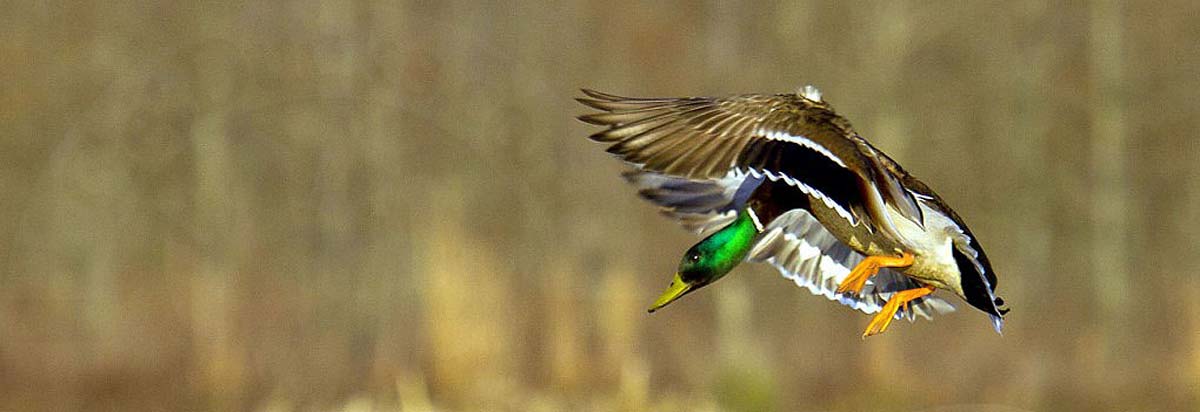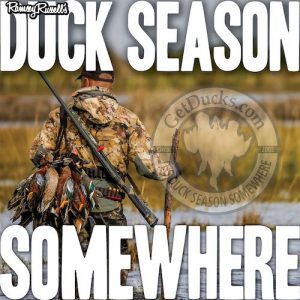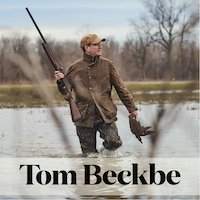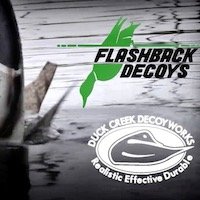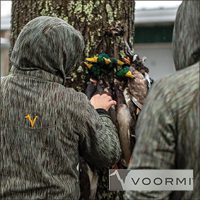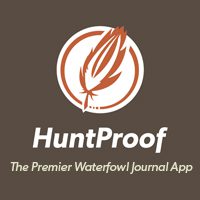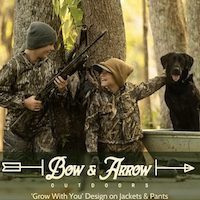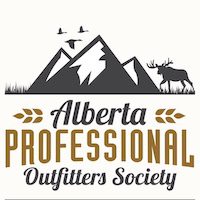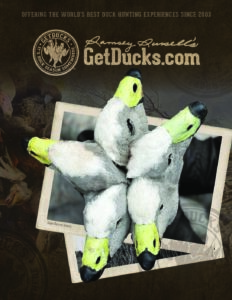Located “between the flyways,” an Alabama duck hunt may lack sheer waterfowl numbers, but cultural enthusiasm for duck hunting remains strong in Alabama. Today’s guests, James Michael Moyer, Jason Russell, and Alabama Migratory Game Bird Coordinator, Seth Maddox, are living proof. How’d these guys get into duck hunting? When did Jason Russell start carving decoys, why’s it important to him, and how has it become a family tradition? How are waterfowl hunting license sales doing in Alabama, and what’s Alabama’s new Adult Mentor Hunter Program all about? While migratory Canada geese have ceased overwintering in northern Alabama (the lost flyway), sandhill cranes have filled the void and their population has subsequently exploded. What exciting new hunting opportunities potentially exist? Tune in to this Duck Seas0n Somewhere podcast episode!
Ramsey Russell: Welcome back to another episode of Duck Season Somewhere and I’m on the tail end of a long North American waterfowl tour and I am in North Alabama. Just like Georgia, I’ve been asked why Alabama? Because you know there’s a lot of Alabama plates, public boat ramps in Arkansas and Mississippi and further out west. I think today’s guests are going to show y’all that Alabama does have a duck hunting culture. They’ve got a duck hunting, Deep South culture. Maybe the hunting is better somewhere else, maybe it’s better where you’re sitting and hunting right now. But that doesn’t make the culture any better, any stronger, and joining me today are James Michael Moyer, Jason Russell and Seth Maddox and I’m going to let them introduce themselves. We’re in what I’ve heard called the Lost Flyway. And what about sandhill cranes? We’re going to explore that today, too. How are y’all doing?
Jason Russell: Very good, yeah.
Ramsey Russell: Everybody, start with you, Jason, introduce yourself please.
How Became Alabama Duck Hunter
Jason Russell: My name is Jason Russell. I have been hunting waterfowl since I was, I guess, 17 – 18 years old. I grew up duck hunting at the banks of the rivers here in northeast Alabama. I’m a decoy carver. And I’ve been hooked on duck hunting since I guess day one on this.
Ramsey Russell: There’s a lot of questions with that right there Jason. Who got you hunting ducks? I’ll ask you all this. How did you become a duck hunter in the great State of Alabama?
Jason Russell: I started in high school. I had a good high school buddy, Johnny Robertson, we grew up playing football together and going to school and hanging out on Friday nights. He invited me to go on a duck hunt one day, and we took my Camaro down to a local creek bank and waded through the mud and we actually killed a mallard, and I was at that moment hooked on it. I was a deer hunter before that or “deer hoper,” wasn’t really good at.
Ramsey Russell: I was a “Deer hoper” back in the days, too.
Jason Russell: Yeah. I realized I could eat and talk and didn’t have to worry about how it smelled and there was something to duck hunting and I liked it, wanted more of it.
Ramsey Russell: Seth, what’s your story?
Seth Maddox: I’m the Migratory Game Bird Coordinator for the State of Alabama. Like Jason, I grew up hunting, you know, my dad wasn’t a big hunter growing up, but he had some friends that were duck hunters there in Northeast Alabama and we went with them and they dragged me along. I was probably 8 or 10 years old when I started duck hunting and I fell in love with it. I didn’t grow up deer hunting. I grew up duck hunting. So that’s my passion. And then I went into this career and love every minute of it.
Ramsey Russell: Do you remember your first duck?
Seth Maddox: Yeah, I don’t exactly remember my first duck. It’s been a long while. Probably a gadwall, if I had to guess because that’s the mallard of Alabama.
Ramsey Russell: Yeah, well that’s a good bird to me.
Seth Maddox: No doubt.
Ramsey Russell: I like gadwall.
Seth Maddox: Yeah.
Ramsey Russell: Sometimes I like. I don’t like them when every pass they’re getting further away. Very bad, right?
Seth Maddox: Yeah, I can.
Ramsey Russell: And James Michael Moyer. What is your background? What’s your story? Who are you?
Adult Onset Duck Hunter
James Michael Moyer: Well, unlike these two guys, I did not grow up a hunter. Probably farthest from a hunter in how I grew up, and it’s always one of those things I always craved to do. For whatever reason, I have no idea why. I had some friends and growing up with it that would go to the various dear leases and stuff like that in high school and middle school or whatnot. I guess sheer willpower to want to do it and just had to find people to take me because I didn’t have access, I didn’t know what the heck I was doing, but probably my third set of grandparents lived next door to me. Richard and Dot Causey. Richard was a schoolteacher in Coleman and he was an avid duck hunter all over north Alabama. And I can remember as a kid, still not being a hunter, just going down there just walking to the bottom of the hill and you know, seeing this turkey that he and Mr. Crutchfield had killed, or a deer. His main passion was ducks and I just don’t know why but I liked it. And every opportunity that I had to be able to go do it, you know, starting in high school squirrel hunting and that kind of stuff with people that knew how to do it. And throughout college, when I moved off to college all of sudden you’re immersed in this, you know, people that you don’t know but always have these family farms and stuff to go back and hunt and stuff like that. So it just grew from there.
Ramsey Russell: And you went to Mississippi State briefly.
James Michael Moyer: Yeah, I went there for a year.
Ramsey Russell: Fell off the wagon, started studying over at Auburn.
James Michael Moyer: That’s right, yeah. My mom went to Tuscaloosa so that made even more difficult.
Ramsey Russell: Every year it must be fun.
James Michael Moyer: It is a matter of fact, my wife gives me a hard time because she’s an Alabama fan, too. And my aunt and uncle give me an Auburn Christmas ornament every single year and my wife now says I have to get my own tree in my own room to put my ornaments on because we have more Auburn ornaments than we do other ornaments on the tree, so. But whoever wins the Iron Bowl gets the highest ornament on the tree, whether it’s Alabama or Auburn, so I guess I’m going to be further down the tree this year. But anyway, you know, that just kind of morphed and helped start the Ducks Unlimited Chapter at Auburn University, when I moved there from Mississippi State and got reintroduced with that when I got out in Birmingham. And then a couple of guys and I started up the Delta Waterfowl Chapter there in Birmingham, four or five years ago. So super involved with that. Just like anything when you hang out with people that are in the industry, you get to meet great people like Seth and Jason and that’s my story.
Ramsey Russell: Well, but I tell you because of you that I’m here tonight, that I got to meet these guys because back this summer, I don’t remember the email or call, but I remember being on the phone with you eventually and you had heard the podcast on MeatEater. You had reached out to me and then ended up sending me the book American Buffalo, which was fascinating. One of the best books I’ve read in maybe several years. [Steve Rinella] did a really good job, by the way he wrote his hunt and history. I couldn’t put the book aside.
James Michael Moyer: The one thing I really have enjoyed about him is, the one difficulty that I’ve always had with hunting in general as it is, is the one thing that always missed me about hunting is getting back to camp and now you see so much, and you ignorant to it because you didn’t grow up around it, but it just grinded on me where people would waste deer meat, or not process their ducks, or not do this and that or, oh it tastes awful and I’m kind of sitting there going, why the heck are we doing this? And you watch various hunt shows and it’s all about killing and that’s it. When I started watching his stuff years ago, it’s just like, this guy gets it because he’s teaching people, a whole different angle. Yeah, there’s a small portion of, yeah, you’re hunting animal and you’ve harvested the animal, but there’s so much more to that. They don’t see the friends in the duck blind, having fun in the morning before the sun comes up. They don’t see back at the duck camp with the people that, process their animals and their grins, and they’re cooking it the right way and sharing it with people that’s never had it before. In my opinion, that’s the right way. And I feel like he does a really good job of communicating that to people that need to hear.
Ramsey Russell: Well, I think we all need to hear it and that’s one thing about it is like I’m not the world’s best cook. In fact, I want to, but I can cook and I have a lot of people reach out to us about how to cook a duck or how about this? How about that? I actually started posting a few of my little recipes and stuff like that on social media. But what I realized some of the questions I get, a lot of people think they don’t know how to cook duck or bear or deer. They just don’t know how to cook. It’s a reach, you go from frozen pizza to a wild game. We’ve all got to learn somewhere.
Seth Maddox: And that’s what turns a lot of people off to it at the beginning. A lot of people are hunters, but they don’t like to eat what they kill. And so it’s handling the meat and cooking the meat and if they get one bad taste in their mouth, that turns them off to the rest of their life. They may not try again.
Ramsey Russell: I agree with that wholeheartedly Seth, and I’ll tell you something else I do like about MeatEater, they’re not speaking just to us hunters. You just talked about getting kind of a late start duck hunting, and I think it’s important this day and age is what they call “Adult-Onset Hunter.” They’re speaking to these guys and I love the opinion. We need way more hunters than we’ve got, not less. And if my public WMA is little too crowded, we just need to get along and deal with it and work it out, because we need more hunters. I really feel like they do as good a job as anybody. And also speaking to the non-hunters because we hunters, some of the conservation agencies, my brand, y’all listening, we’re all used to talking to each other. We’re like the preachers, preaching to the choir instead of going out on the street corner talking to passersby. And I think their message really hits home with a lot of that 80 percent middle ground that needs to be spoken to it. If they don’t want to be hunters, at least understand hunting.
James Michael Moyer: They become subconscious argumentative and not wanting to listen to the other person’s perspective on something and I feel like there’s people out there that have this willful ignorance that they don’t want to hear your side of the story when it comes the hunting in terms of, we helped put a lot of these animals back out in the land that would not have had an opportunity otherwise. And us hunters did that so that the people that don’t hunt can still see it as well, and people need to listen and at least be able to recognize that that’s the case. Simply put it’s us hunters who have paid to do the conservation, to benefit deer and turkey and Sandhill crane in Alabama this year.
Ramsey Russell: That’s a good point. We don’t have to deal with many anti- hunters on our little social media, but to the ones that do dare to come out and criticize, I’m respectful to the point of asking where do you put your time or money? I know where hunters are putting it and I feel like and Seth working for the government could certainly clarify this. I feel like hunters are pulling the wagon, anti-hunters certainly are putting neither time nor money towards it. And I don’t think a lot of non-hunters really are. I think we hunters and it’s not just the game, the excess we are creating to go out and harvest, it’s the non-game benefits. Let’s take ducks or sandhill cranes, we are talking about here for examples. If we hunters are footing the bill for all society, the birdwatchers benefit, the people whose yard to walk around benefit, everybody benefits, the society benefits from that resource, whether they consume it or not. But we hunters foot the bill for it.
James Michael Moyer: You wouldn’t see a deer. You wouldn’t see a turkey, you wouldn’t see an elk, you wouldn’t see a sheep, you wouldn’t see antelope, mule deer..
Seth Maddox: You name it.
James Michael Moyer: Plain and simple because we came pretty close on a lot of that stuff to extinction and going back to the book that I sent you an American Buffalo, I think that’s a very well written book to where back in the day when they did the railroad, they had guns inside the train cars trying to shoot buffalo to keep them off the rails, just crazy stuff like that. And we finally realized that we’ve got to do something. I feel like we all have done that.
Jason Russell: Seth, why don’t you just talk about where the money’s going to?
Alabama Adult Mentored Hunter Program
Seth Maddox: So, the culture is changing as well. People want to know where their meat is coming from. They don’t want to go to grocery to buy it anymore. They want to know that it’s clean, organic source of meat. And so Alabama [Department of Conservation and Natural Resources] started an Adult Mentored Hunter Program as well. Our state agency runs 20 – 30 new hunters a year through that program. And we’re creating new hunters in adult-onset hunters that you’re talking about.
Ramsey Russell: How do you reach out to them? And how would you describe in police sketch artist terms the average adult-onset hunters that respond to this program?
Seth Maddox: Yeah, they’re ranging in age from 20 to 60 years old. We just kind of advertise and we do a few smaller events where they come out to one of our WMA’s. We teach them how to read our WMA maps, how to look for signs. We do a little target practice with them. And then we select from that group a smaller group that we bring out for a three day hunt over the weekend. We have a piece of property that we take them to, one of our special opportunity areas and one of our draw areas, and we have a couple weekends a year where we’re taking a group of 10 or 15 hunters out there. And they’re each paired with a mentor and we go with on a deer hunt first, there’s different tiers of that. We start out with a deer hunt. And so they get to go out and harvest a deer or a pig that place is covered up with pigs as well. After that step up to tier two, either go to turkey hunting or dove hunting and we’re getting ready to step into tier three here pretty soon to where we jump into waterfowl hunting because it’s a little more complicated than deer hunting.
Ramsey Russell: What is the number one? I know, you all are asking them, but of those things that are showing up age 20 to 60 never have hunted. What do they cite as the number one reason they want to become involved as hunters?
Basically, they want to provide food for their family. They want to go out and they want to know where their meals are coming from. – Seth Maddox, Alabama Migratory Game Bird Coordinator
Ramsey Russell: Wow.
Seth Maddox: Exactly.
Ramsey Russell: You know, this conversation and things about listening to MeatEater narrative makes me think that as we recruit more hunters, your neighboring WMA hunter may not be out there to “hammer and grind,” and he might be going to harvest 12 – 13 ducks. Annually. And have nice duck meals for his family. That’s just different than the average mindset today. But I think it’s coming.
Seth Maddox: Sure. Yeah it’s interesting to see these folks and you get a lot of ex-military that come through and people of all phases of life that want to be part of this. They didn’t grow up hunting and have nobody to take them. They didn’t know where to get started. And so we run them through all that. And it’s a way to that we think that we can build more hunters because hunters in the US in general are declining. You know the average hunters probably are 45-50 years old, and as they’re aging though we’re losing money. Our agency, Alabama Department of Conservation and Natural Resources, runs off of license sales revenues. We don’t get any excise tax, we don’t get any tax dollars from the general fund. All our money comes through license sales and that’s a match with the federal government through excise taxes on firearms and ammunition and bow hunting equipment.
James Michael Moyer: Are you seeing more people apply than you can accept, or you taking everybody?
Seth Maddox: Definitely, there’s definitely a need out there for it and we’re kind of maxed out right now on our capacity of what we can do. And so yeah, there’s definitely a need. I know there’s some other states to them, there’s some other agencies.
Ramsey Russell: What other states? I’ve never heard of this program.
Seth Maddox: I think Georgia is doing one. I can’t remember which other states there are, but I know QDMA is doing one nationally.
Ramsey Russell: Did y’all had any corporate involvement, like anybody in the outdoor industry, any company in the outdoor industry stepped in and said, hey, let us offer that job because this is important?
Seth Maddox: Yeah, I think there are some, especially local companies here in Alabama that have stepped up and helped us out with this. You know, it’s really not a big, you know, we don’t have to put a lot of money into it as far as we use all staff for mentors, we have a few volunteer mentors. But we run it through hunter education programs. We’ve got most of the equipment they need already. And so we’re just taking them out there giving them the basics, the ground rules of how to get started. And from there, we’re hoping that they buy their license and continue hunting. Not only that but that they teach somebody else to hunt and they buy the license, too. We want to create a ripple effect here that really provides funding for conservation and brings hunters back to the table.
Ramsey Russell: Really is talking about, hopes will pass it down or share that. That is the whole basis of hunting. That’s how everybody learned to hunt. It’s somebody show them, mentored them.
Seth Maddox: Yeah. It’s got away from that over the years as people stopped hunting and stuff. There’s a ton of people out there that didn’t grow up hunting and never learned how to. They want to learn. So I think that you know it’s a real good program that we’re running right now.
Alabama Sandhill Crane Hunting
Greater Sandhill Cranes
Ramsey Russell: Talking about wildlife populations. Let’s go ahead and ask this question about the Sandhill Cranes in Alabama. What is the history of Alabama Sandhill crane hunting and the population? It was closed for a long time.
Seth Maddox: Right. So there’s five distinct Sandhill Crane populations across the US. In the Eastern United States, Eastern Mississippi River, we have the eastern population which is composed of the Greater Sandhill Crane subspecies, so the larger subspecies. Cranes were hunted to near extinction in the early 1900s, like a lot of other game species. Then in 1918, the Migratory Bird Treaty Act came along and set the ground rules season the bag limits for these species that were traditionally harvested for assessments. And by market hunters to send to the market and that’s kind of what sent it to you know, they were making money off these birds to sell. After that it took a while for the population to come back. I think they started the survey for the Eastern Sandhill Crane population in 1979 and they had around 15,000 birds in the population at that time, which were probably less than 1000 in the early 1900s. It’s grown since then. And today as we speak, the population is over 100,000 birds.
Ramsey Russell: Wow, that’s a heck of a comeback. How have hunters been instrumental in sandhill crane recovery?
Seth Maddox: Its hunters’ dollars. I mean hunters are paying their way. Every dollar spent on a crane license here in Alabama goes back into habitat. So especially duck stamps or duck stamp sales is legislatively tied to wetlands and waterfowl habitat work. Any type of habitat, we’re back on the ground, especially wetland habitat. It’s just keeping those Sandhill Cranes in business when they come down here to Alabama in the winter.
Historically, thousands of Interior Canada geese migrated to northern Alabama in what’s referred to as the Lost Flyway. Canada goose decoys now gather dust, but Greater Sandhill Crane populations have rebounded and are now filling the void.
Ramsey Russell: We were talking at dinner about kind of the Lost Flyway concept. I don’t know what there is to that, but I’ve heard rumors that it had something to do with Canada Goose migration, that parts of northeast Alabama had a huge Canada Goose migrations recorded way back in the days. And you were saying something about sandhill cranes were kind of filling that niche. That in the absence of Canada geese, Sandhills were able to exploit the same resources and explode.
Seth Maddox: Exactly. We used to have 50,000 or 60,000 Interior Canada Geese that migrated down from the southern James Bay to north Alabama. That population dwindled over time to a few thousand birds. And now as the population of Sandhill cranes has been into increase again and they’re expanding their territory back into their historic territory. They filled that niche to where we used to have 50,000 or 60,000 geese there on Wheeler Wildlife Refuge. We now have, 15,000 – 20,000 Sandhill cranes there every year. It continues to increase.
How to Hunt Sandhill Cranes in Alabama
Ramsey Russell: How do you get to hunt these Alabama sandhill cranes?
Seth Maddox: In Alabama we have a drawing every year. And you can apply for the drawing.
Ramsey Russell: Residents only or everybody?
Seth Maddox: Currently its residents only. We don’t know what’s going to happen in the future we’ll see. Hopefully we can open up to nonresidents, if we have enough tags, but we currently have 1200 tag allotment. We dropped 400 permits, and each permit holders will get three tags for the season.
Ramsey Russell: How is the public response been to sandhill crane hunting?
Seth Maddox: You know, people that are hunters, they get it. The hunters are really why we have this season. They wanted what they saw, Kentucky opened sandhill crane season in 2011, they saw Tennessee opening sandhill crane hunting in 2013. And you know, we got a lot of questions of when are we going to open Sandhill cranes season here in Alabama. That’s really what pushed me to want to do it. It took three or four years for us to get that passed through the U.S. Fishing and Wildlife Service. We finally opened up last year in 2019, we had about 600 people apply and we’re going to give up 400 permits. And then this year it grew a little bit so we have a few more people apply and we killed 291 last year which wasokay for the first year. I think it was a success story.
James Michael Moyer: We’ve never hunted them before, so we’ve got to go hunt.
Seth Maddox: It’s been 100 years since sandhill cranes were hunted in Alabama.
James Michael Moyer: It’s a learning curve because it’s completely different setup. I think during dinner we had talked about, you either go set up for cranes if you’re going to spot where you can hunt, you go set up for cranes or you go set up for ducks and geese not both. It’s hard to set on both. You’ve got to make a choice.
Ramsey Russell: Where do you find that out, James? The distinction in successfully hunting cranes versus ducks is?
James Michael Moyer: I’m still learning that. I mean Jason and I, he was fortunate enough to be able to get tags last year. And his son got some crane tags and I had some friends that got a tag. Seth would not accept my bribe to get a tag. He’s un-bribable. But we took those and it’s just kind of trial and error. I mean we talked to different decoy strategies tonight over dinner and I still, I think the next time I go, I’m not going to put out singles decoys because I think maybe now they’re starting to not like it.
Ramsey Russell: I’m no crane expert. But I’ve hunted crane successfully with folks, super realistic decoys, and absolute utter concealment. It doesn’t have to blend in perfectly to the terrain like a duck or goose blind. It can be conspicuous. As long as those eagle eye birds can’t see that’s been my observation.
Jason Russell: To me it was just like a regular duck hunter would do something. You had to be on the mark. You needed to be where they wanted to be, when they wanted to be there, when they want to be there and you have to show them what they wanted to see. Yeah. And if something wasn’t right, you had to change it and adjust. We put out full body goose decoys, thinking that would be okay, like a confidence thing. They were skirting this, that 45 – 50 yards and we don’t want to take that shot and we decided, let’s pull the goose decoys. And as soon as we pull them, they sucked right into our full bodies. And then in a matter of 30 seconds we were shooting them at 20 yards. I mean it was, it was good
James Michael Moyer: I will tell you another thing that surprised the heck out of me was, I knew that they were wary but to be such a big bird to make a decision how they can make it. Ducks can get out pretty quick, a goose can get out quick too. But they’re Sandhills, they make one flap and they’re 90° in the other direction no matter where they are and you would think to be such a big long wingspan bird they can’t turn on dime.
Seth Maddox: They’re certainly fast. And I think the thing in Alabama is that we don’t dry field feed hunt ducks in Alabama. By the time the ducks get here, all that waste grain is either re-sprouted or molded and disintegrated. We don’t have a lot of dry field feeding, so people aren’t used to it. And so dry ground hunting is different in Alabama. It’s one of those things, you have to figure out if you’ve hunted in the Dakotas or in the Midwest for geese or ducks on the dry ground, or if you’ve been hunting Sandhill cranes in the Central Flyway, you probably understand how it works, but hunters in Alabama had never done it before. It’s a learning curve.
James Michael Moyer: We have no clue.
Jason Russell: And we didn’t want to pass you, we want to decoy first. We want them right.
Ramsey Russell: If you ever get Sandhills to do it right get it right. It really is a win. When they’re really killing those decoys, it’s almost like the four of us and if they’re decoying, we’re going to be done in one volley.
James Michael Moyer: Right. You can tell because they’ll stretch out and they’ll start gliding into their spot when they do that. You know, we laughed in the blind like okay, it’s over.
Ramsey Russell: You take forever.
James Michael Moyer: It does because you can see him for miles, and you can hear them for 10 miles.
Ramsey Russell: It’s amazing to me just how far you can hear Sandhill Cranes.
James Michael Moyer: They are deafening in some places.
Ramsey Russell: I’ve heard where it sounds like the right above and I look up, squinting, there’s this little bird dots up in outter space.
James Michael Moyer: And just like a helicopter their sound reverberates off somewhere else. You’ll look one direction and there’ll be a completely other direction. However, they are when they’re in, they’re on you.
Jason Russell: It’s awesome.
Ramsey Russell: What other states are hunting these birds? The Greater Sandhill Crane?
Seth Maddox: Yeah, Eastern Mississippi, it’s only in the Mississippi flyway right now. Tennessee and Kentucky. So those are the other two states. There’s some other states talking about it and I’m sure we’ll see some more states come along.
Ramsey Russell: North of you all, do you think?
Seth Maddox: I think so, yeah. You know the population is really big in the Midwest, they go up in and they breed in the northern Midwest, Wisconsin and Michigan, in southern Ontario and Quebec. And those sandhill cranes come down like a funnel through Illinois, Indiana, Kentucky, and Tennessee and come through northeast Alabama, down through Georgia to Florida. I think Minnesota is of right on the verge, too. Half the state’s got the eastern population, half the state’s got the midcontinent population, which are the one that has been hunting for so long. That midcontinent population is doing real well. There’s over a million sandhill cranes in that population.
Ramsey Russell: I had no idea was that immense.
Seth Maddox: Yeah, they opened the season back up in the Central Flyway in 1961. New Mexico was the first state that got the Sandhill crane season back.
Ramsey Russell: See I did not know that, either. I was recently in New Mexico and got to go Sandhill crane hunting. I got there, and was like Sandhill crane hunting in New Mexico is a thing?
Seth Maddox: Yeah. They’re an incredible bird to hunt and its fun. I’m glad we could also carry 1,200 here in Alabama and we’re excited for the future of this.
Ramsey Russell: It’s good to see it. It’s so easy to get down in the dumps about to mallard limits in the Atlantic flyway or one pintail should be three I heard. But to see hunting opportunities expanding like this, we need more hunting opportunities like this I think.
James Michael Moyer: Yeah, I still say that this is the biggest waterfowl hunting conservation story that nobody is talking about. It’s on the news a little bit but I mean it was 116 years since we’ve been able to hunt these things.
Seth Maddox: Since 1916 when the season was closed before the Migratory Bird Treaty Act was passed.
James Michael Moyer: I mean you think about that, that’s a long time. And now we’ve got tremendous population where the hunters are not going to make a, what do they what do they call the term, the dent or whatever it is.
Seth Maddox: They’re not going to make an appreciable thin the population, so it’s interesting to see. Where even in Tennessee they’re killing a couple 100 a year, maybe 300 – 400 year in Tennessee, a couple 100 in Kentucky. So you know in the flyway right now with three states hunting, we’re still killing less than 1000 birds a year. We could kill up to 10% of the population so we could kill 10,000 year. And we’ll get there eventually I think as other states started opening up it’ll be an allocation of tags among states. Exactly. We’ve got to start somewhere and it’s not every day you get to open a new hunting season to hunters. Last time that happened in Alabama was in 2001 or 2002 when we opened our alligator season back up. So it’s few and far between that, you get to offer new opportunities to hunters to hunt new species.
Jason Russell: Its really exciting, too. It was very exciting to get to do it and just get to be in the draw and then you get drawn and then you have to take a test. You got to take a test to go to identify before you can get your tags and then starting to prep for the hunt. You’re prepping for something you’ve never done and thinking about buying decoys and finding land and scouting differently. It’s just the whole process in a time where the weather has been a little crazy in the last few years. Duck hunting has been a little more difficult in this state the last few years. To me it was the highlight of our season and it gave us a new hope, something to get excited about.
Ramsey Russell: That’s a great point, Jason. Here the question is how is this warmer weather trends on the winters? Are the Sandhill’s photo-period migrators, more or less coming down regardless?
Seth Maddox: No, they’re pretty much like ducks. They’re not photo period migrators. They’re like mallards, and they need that cold. Now we’re going to get some that migrate no matter what. But when you get that cold weather, you can tell that winter population bumps up 10,000 or 15,000. It bumps up there when you get colder weather. But on these years where it’s warmer and slower, we’re still going to get some cranes and we’re going to have enough to hunt. We’re averaging right around 15,000 birds a year in Alabama. And in those years where it gets cold, we may have 30,000 population. Might double here. But they’re hanging around somewhere in Kentucky or Indiana when it’s warmer like that. You know they only want to migrate as far as they have to.
Jason Russell: Gets them to where?
Seth Maddox: Along the Canadian border in southern Ontario or southern Quebec and then you know Wisconsin, Minnesota, and Michigan. That’s their breeding grounds.
Ramsey Russell: It’s an interesting bird because it’s not a waterfowl.
Seth Maddox: Right.
Ramsey Russell: But I see them on some of these waterfowl “must kill species” like for the number of species North America Sandhill cranes for some reason are on the waterfowl species list. It’s not a duck or a goose but it’s hunted like it. It’s hunted most successfully by duck and goose hunters. It’s more like a mourning dove, but with the decoys and hiding in a perfect concealment.
Seth Maddox: The closest thing you can compare sandhill crane hunting is waterfowl hunting.
Ramsey Russell: It is. It’s crazy. I mean coots aren’t hunted like ducks but they’d be more closely related to a Sandhill than a duck.
Seth Maddox: Sure. The other thing is that Sandhill cranes are prehistoric species. The oldest fossil ever recorded in North America is 2.5 million years old found in Florida. They were hunting Sandhill cranes in North America before Europeans ever set foot on the continent!
Ramsey Russell: Isn’t that crazy?
Seth Maddox: That’s crazy.
Ramsey Russell: Wow. You’ve got this population of Greater Sandhill Cranes coming through parts of Alabama but you’re surrounded by a Mississippi, got a Mississippi Sandhill crane endangered, you’ve got to Florida’s Sandhill crane. What other species?
Seth Maddox: We also have Whooping cranes. So those are the big albino crane, those are the white ones, the big white ones. We make our hunters take identification regulations test prior to us sending out their permits and they have to pass that test. We want to make sure that we’re not a detriment to the population of whooping cranes, and that we’re not a detriment to other species too. Like great blue herons or egrets or whooping cranes.
James Michael Moyer: I think that’s important to point out there because a lot of people think that we’re hunting the blue herons. And I think there was a big misunderstanding, if you’re going to see a Sandhill crane, you’ve got to go to a certain point or a certain spot in Alabama to see them and they’re not the herons that you see at your lake or your pond out back. I mean you may see some on some farms in north Alabama.
Ramsey Russell: But sandhill cranes not wading ditches.
Seth Maddox: We created a hunting zone. You pretty much north of Birmingham is our Sandhill crane hunting zone. That’s where the migratory cranes pass through our state. The ones in Florida are non-migratory, the ones in Mississippi are non-migratory. Now we may get one across the state line every once in a while in a little exploratory path, but for the most part they’re staying putting in their general ranges. But for these ones that passed through north Alabama are the migratory Sandhill cranes of the eastern population.
Jason Russell: I think our bigger concern for the state was the whooping cranes. And I know when we were hunting them, we made it a point to when we saw them in the area to not shoot a Sandhill or just to make sure because you don’t even want to question to come up.
James Michael Moyer: We’ve got one nearby. I tell the guys that like we’re just not going to shoot, period. I don’t care where they are. We’re just going to, because if you’ve got a good sign and you’re able to identify the birds as you should they stick out like a sore thumb.
Seth Maddox: And something else we do. We set the season. Daily we don’t open it at 30 minutes before sunrise, like waterfowl. We open it at sunrise. So you have a better chance of identifying that bird before you pull the trigger.
Ramsey Russell: That’s good.
James Michael Moyer: Sandhill cranes usually fly later, like the geese do.
Seth Maddox: Right.
Ramsey Russell: That’s good to hear. But that’s exciting news to me that hunting opportunities are opening up.
Seth Maddox: Yeah, it’s really good for us as a state and I think our hunters enjoy. I hope they do you know hope that we can continue to provide better opportunities for hunters here in Alabama.
Ramsey Russell: Well I hope that after the Fish and Wildlife period get passes that there will be some opportunities maybe because a lot of closer drive to Alabama from Mississippi than Kansas.
Seth Maddox: I’m sure it is.
Ramsey Russell: It’ll be fun to get into that.
Seth Maddox: Yeah, little bigger birdie.
Jason Russell: I suppose we need to talk about how good they are.
Ramsey Russell: I have a couple of questions along in line with, what kind of non-hunter feedback that you all get when you all open your season? Like I just want to get back obviously on a non-hunter.
Seth Maddox: Sure. Yeah, a lot of people thought that we were killing those Mississippi or Florida cranes that people see walk around golf courses or in their backyards that are almost tame. A lot of people thought that we are killing great blue herons and that why we would be killing that, nobody wants to eat a bird that’s eating fish all the time that probably is going to taste like fish. No. We want to kill cranes that are migratory, that have sustainable populations and that are sporting to hunt. And we want to provide a good free range organic meat source to our hunters. Sandhill crane is probably one of the best gamebirds you’ll ever eat.
Are Sandhill Cranes Good to Eat?
Ramsey Russell: Alright I got. If you all kill them enough yet, or eat them enough yet, do you have a favorite recipe?
James Michael Moyer: I like to keep it as simple as possible. Salt, pepper, maybe a little bit of butter to keep a little bit of fat on them. Put on the grill and cook it just like you would steak. I’m a real steak fan, you know, it’s wonderful. And it’s hearty, and it’s filling, and it’s good.
Jason Russell: It’s a little deceptive to me because it looked like I was going to eat a duck or goose. But it tasted more like beef steak.
Seth Maddox: It doesn’t have a lot of fat on it. It’s more like a sirloin. And people call them sirloin, it doesn’t have marbling on it like a steak does but it’s rare to lean. Crane breast that you’re taking off one of our Eastern population Sandhills, these greater Sandhills are 15-16 ounces apiece. Now that’s a huge steak. Yours can be pretty rare in the middle.
Ramsey Russell: You said it’s twice the size of the Central Flyway cranes.
Seth Maddox: Yeah, bigger than the lesser subspecies.
Ramsey Russell: What would one weigh on average?
Seth Maddox: Greater sandhill cranes weigh 14-15 pounds.
Ramsey Russell: Wow. Honestly as big as the bird got in New Mexico that we shot were 8-10.
Seth Maddox: Yeah. So they’re probably 12-14 pounds somewhere in there.
Ramsey Russell: Man that’s a big bird.
Seth Maddox: It is a big bird.
Ramsey Russell: Big Bird.
Seth Maddox: Yeah.
Alabama Waterfowl Decoy Carving Traditions
Jason Russell has passed on decoy carving to his young sons as a way to foster Alabama duck hunting traditions.
Ramsey Russell: Jason. You’ve got kind of interesting stories. I’m going to dig a little bit because you are a decoy carver. Can you introduce yourself as an Alabama decoy carver? I’ve walked around and seen some real nice birds around here, some of your collections and you’ve even got your two sons involved with it. How does somebody in northern Alabama get started down the road with decoy carving?
Jason Russell: Well, like I said grew up here hunting the rivers of Alabama and reading articles about the market hunters and as market hunters, that era came to an end, those guys had to make wooden decoys and put them out there for market hunting, they’d go in there and shoot all those birds. And I just thought it was kind of fascinating that people were actually using wooden decoys and wanted to purchase them. I was a poor college student living on frozen pizzas when I could and couldn’t afford to buy them. So I bought a block of wood and got a pocket knife and started whittling and took a few stitches and cuts here and there and realized that I had an uncle in town who knew his way around wood tools and band saws and he had pedaled with whittling in the past. And so we kind of took a plastic decoy and drew it on a kind of outlined it on a block of wood and kind of hit it from there. But decoys look more like cinder blocks of spray paint on them for about 10 years. And then eventually I made two drake buffleheads that were about three times the size they should be and as probably not, you know, when I’m looking forward and when I’m looking backwards and set them out. But I had a drake bufflehead sit right in the middle of those two drake bufflehead decoys I made. And at that moment, I was hooked. And from there, I’ve continued to do this. And I’ve learned and reached out to some folks across the country because you know, Alabama is not a decoy rich environment.
Ramsey Russell: Are there any historical decoy carvers from Alabama?
Jason Russell: I think there’s a few that are in one of the books to fall flights of Alabama book. But I don’t know, Seth may know a little more traditional. But I don’t think there’s a real traditionally rich history here. It’s not like in Maryland, where there’s a decoy carver on every corner.
Ramsey Russell: Right. Like Havre de Grace.
Jason Russell: Right. So I was fortunate. I got married and had my first computer in the house, I learned about some guys up in Pennsylvania, one of those guys, his name is Bill Kale. Saw his number, and I was kind of bold and brave, and I called him up. He and I struck up a relationship and he would talk to me for hours over the phone, about how to carve a decoy. I didn’t have anything to look at. I could check out a book at the Public Library and actually my wife and I were dating and that was her way of romancing me was she go check out decoy book and bring it to me while I was in college, I’d read it. But I reached out to some mentor and they talked me through some things. And then through that it’s been a neat experience and being able to hunt over my own stuff that’s more than just killing a bird.
Ramsey Russell: Do you ever hunt over plastic decoys?
Jason Russell: I’ve gotten a little bit and it’s some stuff that I’ve been fortunate to be able to be a part of, with some different companies that are out there. Got my boys carving now.
Ramsey Russell: When did they start carving?
Jason Russell: My oldest one started, I think he made his first decoy and he was about six or seven years old, made a little hen bufflehead. And then my youngest son, Jonathan, made his first decoy when he was probably about eight or nine, I guess.
Ramsey Russell: Well, with all the work they have done very well.
Hunter and Grayson Russell after Alabama duck hunt using hand-carved decoys.
Jason Russell: Yes. It’s been neat. We hunted and actually, we hunted over one of Grayson’s decoys yesterday, his very first decoys. So it’s seven, eight years old now, which is really neat. And we do some competition across the country. And Grayson has actually won World Championship for the youth twice. Both boys have done well in national competitions. So it’s been a neat experience to teach them that waterfowl hunting is not just about killing. It’s an experience and putting decoys and making our own duck calls and, and building boats is part of the waterfowling tradition, part of the water fowling heritage that I want them to experience. We have good eyes, but we may not have a good hunts. But we can sit here and we can look and we can make observations about the birds and we can watch them land on the decoys and swim on the decoys and see how they act and look and how they respond. It becomes more than just learning and we get to share that. And even going back to the Sandhill Crane hunting in Alabama, my oldest son was drawn for the hunt. We get to experience that together, we both got to kill our first Sandhill Crane together. What a father-son opportunity. Just like with carving, what an awesome opportunity of memories for me as a father. But then for these guys as they get older and be able to look back at something that they made and they hunt it over and experienced over the years.
Seth Maddox: And that’s a dying art too. Pass it on to your sun pass it on to the next generation that’s a dying art you don’t see people making their own stuff hardly anymore.
Ramsey Russell: And I’ve said this a million times T. I. M. E. That’s how kids spell love. Any opportunity you can have to do spend quality time with your kids. And when my kids were in high school my boys and I were in the duck blind, there wasn’t all the distraction. You can talk a little bit more about the fathers and sons all talk about. I found it to be a great opportunity.
Jason Russell: For me I’ve been able to watch when I’m teaching them. There’ll be times where they may not see it the way I do. And I’ve gotten the oldest one to go in there with my youngest one and help him work out some of the kinks on the carving or work out some of the kinks on the painting. And even with my oldest one Grayson when he carved a green-winged teal, he couldn’t see how I painted or how I wanted him to paint the green on the stripe of the head. And we argued about it a little bit and I walked away and I came back and it was absolutely beautiful. And then I turn around going okay I need you to teach me what you just did.
Seth Maddox: I know you are fast but they’re much better than you.
Ramsey Russell: You know I had a very similar decoy carving experience. I was in college. I wanted to get into it. I couldn’t afford them. and I didn’t know quite the art level you do. I still got squareish center block of duck heads on. I kill ducks over them too. But you know it’s a little more work to take those birds out and hunt with them than just toss the plastics on. It’s a little more work to do it but it’s so much more rewarding.
Jason Russell: It is. You know, in being able to I’ve had out before 150 cork and wood decoy. And that’s a load of timber of you’re carrying in a boat to get it out there but to shoot limited canvasbacks and pull on a few blue bills and maybe a ringneck here and there over hand-carved rig. I mean, a truly hand carved rig of decoys.
Ramsey Russell: You are taking duck hunting to a whole new level. No matter where you hunt. I don’t care where you hunt, duck hunting is duck hunting. Some days you’re just out there, whatever, you’re not shooting a bunch of ducks. And you need those little things to connect you to it. I find value in that. Coming over here and learning the different ways people hunt, the culture and history and styles. It does it for me. I’ll take it, just take it to a little bit different level. Besides, let’s face it, if you took everything that duck hunting is away, it’s definitely true it wouldn’t be nothing but a pile of stinking and wet ducks. It just wouldn’t be nothing to it if you took everything away from it. It’s important to have all those traditions.
Jason Russell: The stories that we have. Just thinking about the pair gadwalls I was telling you about earlier that was my wife’s favorite pair gadwall that I made. She didn’t want me hunting over these gadwall and I’d put probably, you know 25 hours per bird into carving and painting. She liked them and said don’t hunt over these. That’s what I made them for us to hunt over them. So my oldest son, Grayson, and I went out and was going to take those decoys and she told me not to. We did it anyway. And the first gadwall that came in, and it landed there, tried to land right on top of that pair of gadwall and Graysoj had put 17 pellets in that decoy that she didn’t want to take out.
Ramsey Russell: That is a story and I heard that.
Jason Russell: It is. I didn’t fix it.
Ramsey Russell: Did you kill the duck?
Jason Russell: Killed the duck and one of the best hunts we ever had. We shot them close that day. But the character that’s in that decoy, and the memories from all those pellets just the good old laughter there, what happened that day.
Ramsey Russell: It’s been my observation that birds of a feather flock together a lot of times. You talked about bufflehead. Bufflehead you put a bufflehead decoy out there, he’s going to come to that bufflehead decoy. Gadwalls, I use gadwall decoys and put them often among themselves. Gadwalls are going to hit those gadwall decoys.
Jason Russell: Goldeneyes, they are the ones that will do that no matter what. They will scull your decoys, and they’ll give you a long pass and shot, but if you put out three or four or five goldeneye decoys out to one corner, they’ll come in there and sit where they’re going to at least try to see it. So yeah, definitely so buffleheads, name is goldeneyes they are the one that will do that for sure.
Ramsey Russell: Do y’all get enough black ducks still up here in this part of Alabama? Ever see them?
Jason Russell: There are black ducks.
Ramsey Russell: Do you carve a black duck decoy to look at?
Jason Russell: I do carve black duck decoys, I haven’t carved a lot of them, but have carved some of them. That’s actually my wife’s favorite duck is a black duck. It’s just something I think it’s something about that simplicity. Such a pretty bird just sleek and dark and that cream head on there.
Ramsey Russell: I saw online that carver Jason Chuley, had an online black duck contest. It was so amazing how different the styles, the postures, the different styles and even the colors, from almost pitch black to light brown. But they all looked absolutely gorgeous. It is something about a black duck decoy.
Jason Russell: It’s neat to me to see as you go across the country, the different styles. You get the rounded style, the round bottoms with the lead keels. And you get in other places where it’s just kind of a humpback smoothie, you get other places where it’s a more realistic and you get into what’s the traditional gunner versus more of an intricate carving, and the ducks don’t care. I mean, we used to kill divers with milk jugs plain black on both ends. So at the end of the day, I think everybody has kind of their own style. And what are they like? Are you satisfied with what you made? And most of them are not, so I push myself a little bit more. But if I can hunt with something, whether we kill them or not, and just have that experience of going and we did that you know, everything is out there is mine. And it just changes the whole day.
James Michael Moyer: When you have that much time wrapped up in a decent amount of decoys. What’s the most time you ever spent on a decoy?
Jason Russell: I’ve got a gadwall that I think I’ve got about 50 hours in the process.
Ramsey Russell: You did it all by knife, you said.
Jason Russell: I did it all by knife.
James Michael Moyer: So how do you decide, okay, I know I’ve got 50 hours or say 40 hours that I’ve got to spend on this decoy, where is your mind going first? Like that’s an enormous amount of time to actually sit down and work on something. How do you say I’m going to build X duck next, what is that?
Jason Russell: With that one gadwall in there, it’s interesting. I would with my son going to soccer practice, I would sit at soccer practice and just kind of unwind. And I would take a knife and draw and cut, it is interesting because the soccer team would get distracted and come over and want to watch me. I’d say okay, you all go back and play soccer. So that one’s got a lot of time just because I had the time. Now sometimes you get commissioned birds and they want a little bit more in there. So I’ll do it according to what is required.
James Michael Moyer: So you have a person call you and say how they want it.
Jason Russell: Yeah, they want a certain bird with maybe raised wings and birdie details, some may have 25 to 40 hours in a bird. And then again, there’s that turns right. I just like the good old plain simple rounded gunning decoys, and I got a bufflehead in there I’ve probably got four or five hours in it. The whole bird start to finish. Nasty stuff I like is you know, just a meat hunt decoys and some guys are still like that. So it depends on who am I doing it for? Do I need a mental break and I just want to keep carving and make those good grinding birds, or do I want to take my time and you know, make something a little more unique and a little more special?
Seth Maddox: What I like about Jason is that no matter how intricate he wants to have that decoy, he’s not putting it on the shelf. He’s hunting over it.
Ramsey Russell: I am not a big collectible decoy guy. I think all ought to be floated and hunted over. I was talking to Bobby Jobes the other day he says he sells a lot of mallard decoys that don’t have a story. If they don’t float, they don’t have a story he said. There’s a lot of truth there. Probably everybody listening to this podcast know that migratory birds migrate, that duck hunters want to hunt. If guys listening haven’t hunted somewhere else he has to go and do it. That’s what we duck hunters do. But having been here for a few hours, I’ve noticed that a duck carver is taking you outside of Alabama. You may be an Alabama carver, but you’ve got a sneak box in the garage. Can you talk about that? How did that all come about?
Jason Russell: The boat or just traveling?
Ramsey Russell: I know you’ve been to Havre de Grace, I know you’ve been around New Jersey.
Jason Russell: I’ve been to Ocean City, Maryland with it. I’ve been Ohio, one of the great lakes in Ohio. I’ve hunted in Missouri.
Ramsey Russell: And that’s through decoy carving?
Jason Russell: All of it through the decoy carving. So it’s interesting. I’ve got a good friend out in Missouri right now who’s a carver and because of that relationship, the uniqueness of it and his mentorship for me. It brings us together as a family. I’ve got friends in Ohio. I’ve been fortunate. I’ve never been able to hunt there if it wasn’t for the carving relationship, and us working together and having that unique interest of not just killing the birds but spending time together. And I’ve had people from Ohio send their kids down to hunt with me through the carving community, and just getting to go all over and getting to share with people and then getting to go to Louisiana hunt and see the cajun carvers that are making them out of cypress roots. Just fascinating. And then the interesting things like the Barnegat Bay sneak boat. That is traditional. That boat was built in 1963 and there was some guy up in New Jersey, push poling that boat at some point along the water sculling big decoys, to shoot black duck out of this. It’s fascinating, and that boat is still in existence. It’s a white cedar plank built boat that’s in my garage. I get to hunt over it and get out of it over my decoys in Alabama.
Ramsey Russell: Do you hunt at Alabama, do you kind of abide the seven duck or nine duck hunting when you got a conventional spread and you kind of go with mallards?
Using Coot Decoys to Hunt Ducks
Jason Russell shows part of his hand-carved decoys. Because coots are abundant, his Alabama duck hunting rig includes coots.
Jason Russell: That boat doesn’t allow you to carry a big load. So it’s nice to have puddle ducks out because you pull up into grass pretty easily. You pull up under a tree or for hunting divers, I can put a smaller spread out. I like to make coot decoys and I like to hunt over coot decoys. If I got a dozen, two dozen coot decoys with me along with three or four canvasbacks. I can pull up in the grass, hide, put my decoys out and kind of disappear.
Ramsey Russell: Second consecutive conversation on podcast, I’ve talked to somebody that makes and hunts over coot decoys. Why do you want to hunt with coot decoys?
Jason Russell: For me, two things. It’s what we see in the Tennessee River Valley is coots. I mean large numbers, sometimes thousands of them and the ducks, the gadwalls, sit with the coots. The canvasbacks sit the coots. The rednecks sit with the coots. Because they’re comfortable. If you pull up to a flock, they disappear and you can’t even see the ducks in there. A lot of times at least to the puddle ducks and they’ll get up and move out. We have so much boat traffic on our lake you can see that the coots will turn and start to move when they hear a boats, there’s safety in coots. I think if you’re just throwing out all white decoys, it works. But at the same time, there’s just something for me to go. I like to match the environment of the natural. We’ve got coot, that’s where the birds are. I like to put coots out. It looks like what we see.
Seth Maddox: We have a lot of aquatic vegetation on the lake. Milfoil, coon-tail moss, all that stuff. So those coots are eating on that and so ducks joining right in with them and a lot of time stealing it right out of their mouth. Yeah, it’s one of those things that you know, they just feel comfortable, you know, being together. It’s like a confidence thing. To throw a bunch of coots, it looks it looks natural, because there’s a lot of coots around.
Can you eat coots?
Ramsey Russell: Do you eat coot?
Jason Russell: I eat coot. And I always say that a man that says a coot doesn’t taste good has never eaten one.
Ramsey Russell: Probably same man that doesn’t eat Sandhill Crane.
Jason Russell: Right. And when you think about a coot, it’s not flying as much, it’s not pumping that breast full of blood, It’s eating vegetation and it’s got a little bit of fat on it. They’re swimming, so their legs might be pumped full of blood. It is a tasty meal. My youngest son would rather eat a coot than anything.
Ramsey Russell: He didn’t understand what the big deal was about canvasbacks.
Jason Russell: Right because he said he would pretty much rather eat a coot than a canvasback. That’s a big statement. And you’re talking about canvasbacks are good. It’s on my favorites list. It’s tender and they’re eating that grass or the wild celery, that’s what’s in our lake. But there’s something about a good old coot. I’d actually cooked one the other day, coot, and didn’t tell him what it was till after he was over with.
Ramsey Russell: How do you cook it?
Jason Russell: I do two different things. I either take it, and do a dry rub, will pat the meat dry, put a dry rub on it and we’ll put it on the grill not directly on the fire but off to one side. Three minutes on each side, cooks quick with medium rare and then I might go and do one more minute or I do the old traditional stuff with an apple that’s what my boys like they like to say this stuff with an apple.
Ramsey Russell: Like a little pocket it maybe put like a green apple.
Jason Russell: Yep and then wrapping bacon just like you would anything yes like you would have done.
Ramsey Russell: Wow that’s what I’m going to try.
Jason Russell: An apple is excellent.
Ramsey Russell: Did you ever do your duck that way?
Jason Russell: Yes, I do my ducks the same way and do peppers onions but my boys don’t like peppers and onions that much. But they like an apple, it’s got that sweet flavor in there.
Ramsey Russell: Ducks lend themselves to sweet and fruity. It’s so good.
Ramsey Russell: Without marinating them?
Jason Russell: So good.
Jason Russell: Here’s what’s interesting, we started doing our duck with this dry rub without marinating them.
Ramsey Russell: What kind of dry rub?
Jason Russell: Any kind of like a buck rub or something? Like it kind of steak rub, it’s been excellent. Now if I do my bacon, I marinate for about 30 minutes I like it. There’s a product called Moore’s it’s not quite as salty. I do it for about 20-30 minutes. I usually soak my meat in water, not in salt water, for about two to three days. Let it bleed out a little bit, butterfly it open, stuff it, wrap it, turn it on the grill. When the bacon is done, it’s ready to come off.
Alabama Duck Hunt
Ramsey Russell: Let’s talk about tomorrow morning. What’s going to happen tomorrow morning? What do we hope is going to happen? What could happen tomorrow morning? What are we going to do?
James Michael Moyer: Hopefully we see a duck. It’s been pretty tough here. Like it has been in the more traditional areas your Arkansas or Mississippi so when those states were hunting even worse. Like I was telling you on the way over here is, I really like hunting my Alabama spots and around Thanksgiving and Christmas because at New Year’s I get to spend more time with my family and they usually produce and for whatever reason, if the other states are hurting we tend to hurt a little worse. We hope that we started on Sunday and I’ve found maybe more than a handful of mallards has been coming in every morning and hopefully, fingers crossed, they decide to do it again tomorrow. But you know, 65 degrees today and I’ve been wearing flip flops in the blind. I hope I hope we’re able to do it, really do.
Jason Russell: 60 degrees tomorrow and snow the next day.
James Michael Moyer: Yeah, good point.
Seth Maddox: That’s Alabama.
Ramsey Russell: 60 degrees tomorrow and snow the next day. I was in Montana and recently it was 80 degrees. And my hosts were like, best head on down to Utah, we got blizzard coming in and I’m like, get out here, 80 degrees. And then I started getting texts from some of the locals saying, hey, if you get stuck you’re welcome to come over to eat dinner. And I’m like, no, I’m getting out here. And sure enough, blizzard hit and there’s no way I’d gotten to that pass. It was unbelievable how the weather changed on a dime like that.
James Michael Moyer: We did that one year up on Reelfoot Lake, and we were hunting and if you’ve never hunted on Reelfoot, you need to go do that in Tennessee sometimes because it’s a different experience. And you just got to go to do it. But a buddy of mine has got a picture of me hunting shorts at a one of those barns on one day. And the very next day, the friend that we were hunting with and had the opportunity to hunt with works for T-dot. And he basically said you all need to leave now in order to get below whatever interstate it is that runs east and west, because they’re about to close the whole thing down. And sure enough, what usually takes four and a half, maybe five hours to get to Union City, Tennessee. I think it took us 13 hours to get home. Because it was that storm in January like three or four years ago. Actually, it was 2016. And it was just nuts. But the day before I was hunting in shorts, and it’s the long sleeve t shirt. There were trucks just all over the interstate, 18 wheelers balled up. That’s Alabama weather for you.
Jason Russell: Hopefully tomorrow we have few birds, we could share one. We could share some stories.
Seth Maddox: 100% his decoys.
Jason Russell: 100% my decoys. I’ve got a rig kind of mounted rig, just simply five hours a gadwall. The first one in the rig was carved in 2001. And the last was in 2016. So we got birds that are 20 years old that have hung around and had a lot of stories to be told over.
Ramsey Russell: Hope we make some more stories over them all. If any of you all want to share some ways that listeners can get in touch with you all on social media or otherwise?
Seth Maddox: outdooralabama.com is our website for the state of Alabama. They can find all the waterfowl information there for the state of Alabama, and then for the Sandhill Crane next year. If you’re a resident, you know, hopefully we open it to the non-residents in the future. There’s a lot of good information on there about waterfowl hunting in Alabama.
Ramsey Russell: Fantastic. All right, folks, y’all I’m in Alabama, Northern Alabama. The Lost Flyway. Y’all have been listening to James Michael Moyer, Jason Russell and Seth Maddox, who I appreciate the hospitality and have after great barbecue tonight. I’m looking forward to experiencing real Alabama duck hunting in the morning. Folks, thank you all for listening to this episode of Duck Season Somewhere podcast. The Road goes on forever. Look forward to seeing you again next week.
Ducks Season Somewhere podcast is brought to you by the following sponsors:
GetDucks.com, your proven source for the very best waterfowl hunting adventures. Argentina, Mexico, 6 whole continents worth. For two decades, we’ve delivered real duck hunts for real duck hunters.
USHuntList.com because the next great hunt is closer than you think. Search our database of proven US and Canadian outfits. Contact them directly with confidence.
Benelli USA Shotguns. Trust is earned. By the numbers, I’ve bagged 121 waterfowl subspecies bagged on 6 continents, 20 countries, 36 US states and growing. I spend up to 225 days per year chasing ducks, geese and swans worldwide, and I don’t use shotgun for the brand name or the cool factor. Y’all know me way better than that. I’ve shot, Benelli Shotguns for over two decades. I continue shooting Benelli shotguns for their simplicity, utter reliability and superior performance. Whether hunting near home or halfway across the world, that’s the stuff that matters.
GunDog Outdoors. Sit means sit and stay until it doesn’t. No matter how well or how often trained, retrievers want those ducks as badly as we do. Maybe even more. Char Dawg might be titled, but she’s still just a dog. I’m over 50 years old and I still do dumb stuff, trust me. Retrievers are family. I wouldn’t endanger my children near heavy traffic, and I’m not going to risk my dog jumping in front of blazing guns either. GunDog Outdoor’s patented, quick -release safety system is fully adjustable, tethers to any blind or stand, has titanium stakes for frozen ground, and a quick-release marine-grade shackle to quickly release Fido when the smoke clears. Visit gundogoutdoors.com, connect with them on Instagram @gundogoutdoors to see their growing line of gun dog safety and performance products. Enter #getducks to receive 15% discount off of your first order.
Mojo Outdoors, most recognized name brand decoy number one maker of motion and spinning wing decoys in the world. More than just the best spinning wing decoys on the market, their ever growing product line includes all kinds of cool stuff. Magnetic Pick Stick, Scoot and Shoot Turkey Decoys much, much more. And don’t forget my personal favorite, yes sir, they also make the one – the only – world-famous Spoonzilla. When I pranked Terry Denman in Mexico with a “smiling mallard” nobody ever dreamed it would become the most talked about decoy of the century. I’ve used Mojo decoys worldwide, everywhere I’ve ever duck hunted from Azerbaijan to Argentina. I absolutely never leave home without one. Mojo Outdoors, forever changing the way you hunt.
BOSS Shotshells copper-plated bismuth-tin alloy is the good ol’ days again. Steel shot’s come a long way in the past 30 years, but we’ll never, ever perform like good old fashioned lead. Say goodbye to all that gimmicky high recoil compensation science hype, and hello to superior performance. Know your pattern, take ethical shots, make clean kills. That is the BOSS Way. The good old days are now.
It really is Duck Season Somewhere for 365 days. Ducks Season Somewhere takes me year-round to worldwide destinations where I meet the most interesting people. I’m your host Ramsey Russell. Join me here to listen to those conversations. Welcome to Duck Season Somewhere.

